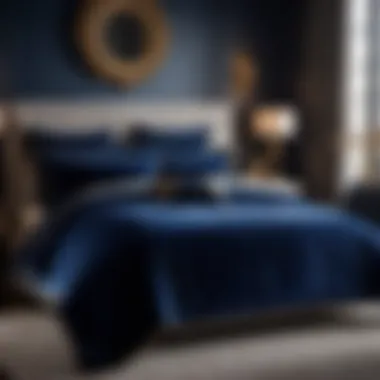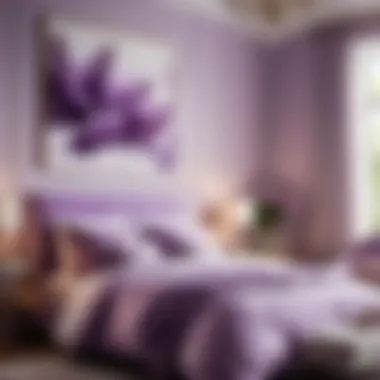Elegant Bedroom Hues: A Detailed Guide to Contemporary Color Trends


Materials:
- Paint: 2 gallons of Serene Blue, 1 gallon of Tranquil Gray
- Paintbrushes: 1 medium brush, 1 small detail brush
- Painter's tape: 2 rolls of delicate surface tape
- Drop cloths: 1 large cloth to protect the floor
DIY Steps:
- Preparation: Clear the room of furniture and cover the floor with a drop cloth to protect it from paint.
- Select Colors: Choose Serene Blue for the main walls and Tranquil Gray for an accent wall.
- Surface Prep: Clean the walls, fill any holes or imperfections, and apply primer if needed.
- Tape Off: Use painter's tape to define the edges, creating clean lines between the Serene Blue and Tranquil Gray sections.
- Painting: Start with the main walls in Serene Blue, using a roller for efficient coverage. Allow to dry before moving on to the accent wall in Tranquil Gray.
Technical Aspects:
- Tools: Paintbrushes for detail work, roller for broad strokes
- Timing: Plan for a weekend project to allow ample drying time between coats
- Techniques: Use long, even strokes for a seamless finish, remove tape carefully to avoid smudging
DIY Project Process:
- Installation Method: Apply the first coat of Serene Blue, ensuring even coverage. Let dry completely before applying the second coat.
- Key Techniques: Feather the edges for a smooth transition between colors, avoid overloading the brush to prevent drips.
- Timings: Allow each coat to dry according to the paint manufacturer's instructions for best results.
Troubleshooting Tips:
- If tape removes paint upon peeling, use a utility knife to score along the edge before removal
- For accidental smudges, let the paint dry completely, then carefully sand and repaint the affected area for seamless touch-ups.
Introduction
In this comprehensive guide on exploring trendy bedroom colors, we embark on a journey through the intricate world of interior design. The importance of selecting the right colors for your bedroom cannot be overstated, as they have a significant impact on our daily lives and overall well-being. The colors we choose to surround ourselves with in our most intimate space can influence our mood, emotions, and even our quality of sleep.
When it comes to interior design, colors play a crucial role in setting the tone and atmosphere of a room. The bedroom, in particular, is a sanctuary where we seek relaxation and serenity after a long day. Therefore, the choice of colors for this space should reflect our personal preferences while also aligning with the desired ambiance we wish to create.
In this article, we will delve deep into the psychology of colors, exploring how different hues can evoke specific emotions and feelings. Whether you prefer the calming effect of soft neutrals or the invigorating energy of vibrant jewel tones, understanding the psychological impact of colors will empower you to make informed decisions when revamping your bedroom decor.
Furthermore, we will showcase popular bedroom color trends, from soothing neutrals like soft beige and warm gray to nature-inspired hues such as earthy browns and forest green. Each color palette has its unique characteristics and associations, allowing you to express your personal style and create a harmonious environment that resonates with you.
As we navigate through this guide, we will also provide practical tips and insights on how to incorporate colors effectively in your bedroom. Whether through accent walls, bedding choices, or furniture selection, every detail contributes to the overall aesthetic of your space. By gaining a deeper understanding of color psychology and design principles, you will be equipped to transform your bedroom into a captivating retreat that reflects your taste and personality.


Understanding Color Psychology
In the realm of interior design, understanding color psychology plays a crucial role in creating the desired ambiance within a space. Colors have the power to evoke emotions, influence moods, and even affect the perception of a room's size. When it comes to bedroom decor, the choice of colors can significantly impact the overall feel of the space. By delving into the psychological effects of various hues, homeowners can curate a bedroom environment that promotes relaxation, energy, or balance. From soft neutrals to vibrant jewel tones, each color holds specific connotations that can be harnessed to craft a personalized haven.
The Impact of Colors on Mood
Warm Colors
Warm colors such as reds, oranges, and yellows are known for their ability to create a cozy and inviting atmosphere. These hues tend to stimulate the senses, instilling a sense of warmth and intimacy in a room. Red, for instance, can increase heart rate and energy levels, making it a suitable choice for spicing up a bedroom decor. However, it's essential to use warm colors in moderation, as an excess of these hues may lead to feelings of aggression or restlessness.
Cool Colors
On the other end of the spectrum, cool colors like blues, greens, and purples have a calming effect on the mind and body. These tranquil hues are ideal for promoting relaxation and fostering a sense of serenity in a bedroom. Blue, often associated with calmness and clarity, can help lower blood pressure and reduce anxiety levels, making it a popular pick for creating a peaceful sleep environment.
Neutrals
Neutrals, including soft beiges, warm grays, and creamy whites, serve as versatile backdrops in bedroom design. These understated tones provide a sense of balance and sophistication, allowing for easy integration of bolder accent colors or patterns. Neutrals are timeless choices that can adapt to changing decor trends while imparting a sense of tranquility and harmony to the bedroom space. Experimenting with different shades of neutrals can add depth and dimension to the room, creating a soothing retreat for rest and relaxation.
Popular Bedroom Color Trends
When it comes to creating a stylish and harmonious bedroom space, choosing the right colors is crucial. Popular bedroom color trends play a significant role in setting the ambiance and overall aesthetic of a room. By staying abreast of the latest color trends, homeowners can elevate their bedroom decor to new heights. Understanding the significance of popular bedroom color trends allows individuals to make informed decisions that align with their personal style preferences and desired atmosphere.
Soothing Neutrals
Soft Beige
Soft beige is a versatile and timeless color choice for bedrooms. Its warm undertones create a sense of coziness and tranquility, making it ideal for relaxation. Soft beige contributes to a serene atmosphere and pairs well with various accent colors, enhancing its adaptability in different decor schemes. The key characteristic of soft beige lies in its ability to promote a calming environment, fostering restful sleep and peaceful evenings. While soft beige may appear subtle, its understated elegance adds a touch of sophistication to any bedroom setting.
Warm Gray
Warm gray exudes a sense of sophistication and modernity. Its neutral quality allows for easy pairing with different textures and materials, making it a versatile choice for bedroom decor. The key characteristic of warm gray is its ability to create a refined and polished look while remaining understated. The unique feature of warm gray lies in its ability to serve as a backdrop for bolder accent pieces or as a standalone statement color. While warm gray may lack the warmth of other hues, its cool undertones lend a sense of calm and balance to a bedroom space.
Creamy Whites


Creamy whites offer a sense of purity and luminosity to any bedroom. The key characteristic of creamy whites is their ability to reflect light, creating an illusion of spaciousness and airiness. Creamy whites contribute to a sense of cleanliness and freshness, promoting a serene environment for relaxation. The unique feature of creamy whites lies in their adaptability to various design styles, from minimalist to classic. While creamy whites can brighten a room, they may require careful maintenance to preserve their pristine appearance.
Vibrant Jewel Tones
Emerald Green
Emerald green brings a touch of luxury and vitality to bedroom decor. Its rich and intense color elevates the ambiance, infusing the space with energy and sophistication. The key characteristic of emerald green is its ability to create a lush and opulent atmosphere, reminiscent of nature's beauty. Emerald green stands out as a refreshing and bold choice, adding depth and personality to a bedroom setting. While emerald green may make a strong statement, incorporating it in moderation can enhance the overall aesthetic without overwhelming the space.
Sapphire Blue
Sapphire blue evokes a sense of tranquility and elegance in the bedroom. Its deep and calming hue promotes relaxation and serenity, making it an excellent choice for creating a peaceful retreat. The key characteristic of sapphire blue lies in its ability to soothe the mind and create a restful environment conducive to sleep. Sapphire blue's unique feature is its versatility in blending with both warm and cool color palettes, offering a timeless appeal to any bedroom space. While sapphire blue brings a sense of sophistication, careful consideration of lighting and complementing elements is essential to maintain balance in the room.
Ruby Red
Ruby red introduces a passionate and dramatic element to bedroom decor. Its bold and vibrant hue adds warmth and intensity to the space, creating a sense of romance and sensuality. The key characteristic of ruby red is its ability to evoke emotion and captivate attention, becoming the focal point of the room. Ruby red's unique feature lies in its transformative quality, instantly infusing a sense of energy and intimacy into the bedroom. While ruby red can make a striking statement, integrating it thoughtfully through accessories or accent pieces allows for a balanced and cohesive design scheme.
Nature-Inspired Hues
Earthy Browns
Earthy browns bring a sense of grounding and comfort to bedroom interiors. Their warm and earthy tones create a connection to nature, fostering a cozy and inviting atmosphere. The key characteristic of earthy browns is their ability to add a sense of stability and warmth, making them ideal for creating a nurturing environment. Earthy browns' unique feature lies in their capacity to harmonize with other natural elements, such as wood and foliage, enhancing the room's organic feel. While earthy browns lend a sense of richness to a space, balancing them with light hues can prevent the room from feeling too dark or heavy.
Forest Green
Forest green embodies the serenity and freshness of lush landscapes within the bedroom. Its deep and invigorating shade adds a revitalizing touch to the decor, creating a connection to nature's rejuvenating qualities. The key characteristic of forest green is its ability to evoke a sense of tranquility and balance, encouraging a peaceful and unwinding atmosphere. Forest green's unique feature lies in its versatility to complement various design themes, from rustic to contemporary. While forest green brings a sense of vitality to the room, incorporating natural textures and elements can enhance its organic appeal and create a harmonious environment.
Sky Blue
Sky blue evokes a feeling of lightness and tranquility in the bedroom. Its soft and calming hue imparts a sense of serenity and relaxation, ideal for promoting restful sleep and peaceful moments. The key characteristic of sky blue is its ability to create a soothing and airy atmosphere, reminiscent of clear skies and open spaces. Sky blue's unique feature lies in its versatility to coordinate with a wide range of colors, enhancing its adaptability in various design schemes. While sky blue introduces a sense of freshness to the room, incorporating elements inspired by nature can amplify its calming effect and enhance the overall ambiance.
Tips for Incorporating Colors in Your Bedroom


In the realm of interior design, the importance of incorporating colors in your bedroom cannot be understated. Choosing the right colors can significantly impact the ambiance, mood, and overall aesthetics of your personal space. When crafting a harmonious color scheme for your bedroom, consider elements such as wall color, bedding, textiles, furniture, and decor accessories.
One essential tip for incorporating colors in your bedroom is to start by selecting a cohesive color palette. This involves choosing a primary color that will serve as the foundation for your room's design. From there, you can layer in accent colors to add depth and visual interest. Consider the size of your bedroom and the amount of natural light it receives when selecting colors. Lighter hues can make a small room feel more spacious, while darker tones can create a cozy and intimate atmosphere.
Another crucial aspect to consider is the psychological impact of colors. Warm tones like reds, oranges, and yellows can evoke energy and warmth, making them ideal for stimulating spaces. In contrast, cool colors such as blues, greens, and purples promote relaxation and tranquility, perfect for creating a serene bedroom environment. Neutrals like whites, grays, and beige can act as versatile backdrops, allowing you to introduce pops of color through decor accents.
When incorporating colors in your bedroom, remember the 60-30-10 rule. This guideline suggests using 60% of a dominant color, 30% of a secondary color, and 10% of an accent color to achieve a balanced and visually appealing look. Experiment with different color combinations and textures to add depth and personality to your bedroom space.
Accent Wall
An accent wall is a popular design trend that involves painting or decorating one wall in a room with a bold color or eye-catching pattern to create a focal point. When incorporating an accent wall in your bedroom, consider the wall opposite the entrance or the wall behind the bed for maximum impact. Bold colors such as deep blues, rich greens, or vibrant yellows can instantly transform a dull bedroom into a dynamic and visually engaging space.
To ensure a cohesive look, coordinate the accent wall color with other elements in the room, such as bedding, curtains, and decor accessories. Use wall art, mirrors, or shelves to enhance the accent wall and tie the design elements together. Remember to balance the boldness of the accent wall with complementary hues elsewhere in the room to maintain harmony and visual appeal.
Bedding and Textiles
Bedding and textiles play a crucial role in enhancing the color scheme of your bedroom. When selecting bedding, consider the overall color palette and theme of your room. Opt for soft and comfortable fabrics that complement the style of your decor. Mix and match different textures, patterns, and colors to create visual interest and depth.
Choose bedding in colors that resonate with your desired mood and ambiance. Serene neutrals like whites, creams, and light grays can promote relaxation and tranquility, while vibrant hues like blues, greens, or purples can add a pop of color and energy. Experiment with different pillow arrangements, throws, and blankets to elevate the visual appeal of your bed and enhance its comfort.
When it comes to textiles, incorporate curtains, rugs, and cushions that align with your color scheme. Consider the material of each textile and its tactile quality to create a sensory experience in your bedroom. Layering textiles of varying colors and textures can enrich the overall look and feel of the space, making it inviting and cozy.
Furniture and Decor Accessories
Furniture and decor accessories are essential elements for adding personality and style to your bedroom. When selecting furniture pieces, pay attention to the color, material, and design to ensure they complement the overall color scheme. Opt for furniture in neutral tones to create a versatile backdrop for bolder accent colors in the room.
Choose decor accessories that reflect your personality and taste while enhancing the color palette of your bedroom. Introduce artwork, vases, lamps, and decorative objects in coordinating colors to tie the room together. Use plants and greenery to bring natural elements and vibrant pops of color into your bedroom space.
Consider the scale and proportion of furniture and decor accessories to maintain a harmonious look. Avoid overcrowding the room with too many pieces; instead, focus on selecting a few statement items that contribute to the overall color scheme and aesthetic. By carefully curating your furniture and decor elements, you can create a cohesive and visually pleasing bedroom that reflects your style and sensibilities.
Conclusion
In the realm of trendy bedroom colors, the conclusion serves as a pivotal moment where all the insights and guidelines culminate into actionable steps for creating the perfect color scheme in your bedroom. This article has meticulously dissected the psychological impact of colors, explored popular trends, and provided invaluable tips for seamlessly integrating them into your decor. By understanding the nuances of color psychology and trend dynamics, readers are equipped with the knowledge to transform their bedroom into a sanctuary of style and comfort.
One of the key elements emphasized throughout this comprehensive guide is the importance of striking a balance between personal taste and functionality when selecting bedroom colors. While trendy hues can enhance aesthetics and create a modern vibe, considerations like relaxation, ambience, and individual preferences should not be overlooked. The conclusion serves as a gentle reminder to harmonize style with comfort, ensuring that the chosen colors resonate with the inhabitants' unique personality and promote a soothing environment conducive to rest and rejuvenation.
Moreover, the benefits of thoughtful color selection extend beyond mere aesthetics. Colors have the power to influence mood, invoke emotions, and set the tone for the space. By carefully curating a color palette that aligns with the desired ambiance, individuals can create a personalized oasis that caters to their specific needs, whether that be a tranquil retreat for unwinding after a long day or an energizing haven for starting the morning on a vibrant note.
As we wrap up this exploration of trendy bedroom colors, it's important to acknowledge that the journey from selecting colors to enjoying the final result is an enriching experience that goes beyond mere decoration. It involves understanding oneself, expressing creativity, and curating a space that truly feels like home. By following the tips and insights laid out in this guide, readers are empowered to embark on a transformative journey of color discovery and design innovation, ultimately leading to a bedroom that not only looks stylish but also feels like a personalized sanctuary tailored to enhance daily living.







